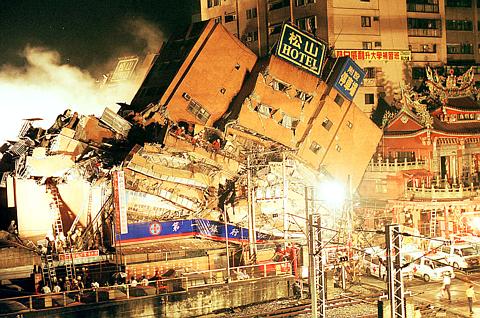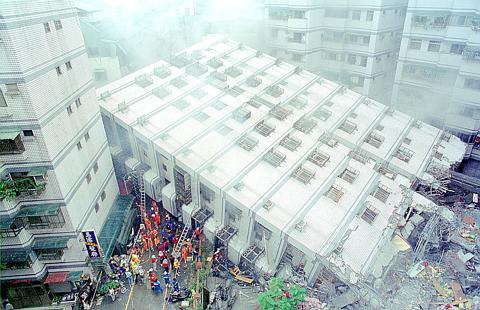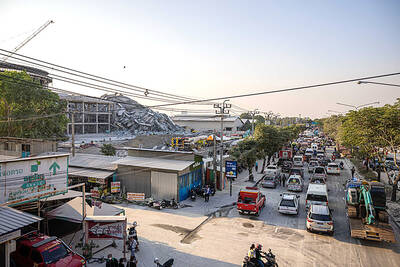As the international community poured out condolences and sent rescue workers to Taiwan last night to join the desperate search for survivors of yesterday's earthquake, the nation continued to count the loss in life and property caused by its biggest temblor this century.
By midnight yesterday, a total of 1,712 people were reported killed, 4,005 injured, 219 missing and 2,991 trapped inside buildings, according to the Ministry of the Interior's disaster management center. About 30,000 houses were damaged or destroyed.
Meanwhile the first foreign group of rescue workers, comprising 71 professionals and six government officials, arrived from Japan, the Ministry of Foreign Affairs said.

PHOTO: CHEN CHENG-CHANG, TAIPEI TIMES
Chinese President Jiang Zemin extended condolences and offered aid to the quake victims, even though the disaster occurred at a time of tense relations between China and Taiwan.
Thanks were expressed in Taiwan, with Su Chi (
President Lee Teng-hui (

PHOTO: GEORGE TSORNG, TAIPEI TIMES
Legislative Speaker Wang Jyn-ping (
Minister of Finance Paul Chiu (
The quake struck at 1:47am yesterday morning, 12.5km west of Sun Moon Lake (
Since the main earthquake, the island has been struck by at least 36 major aftershocks among a total of 600 aftershocks of various strengths.
The quake caused power outages almost islandwide, though as of press time Taipower said electricity had been restored to 59 percent of the island.
Damage was sustained across nearly the entire island, mostly from Chiayi in the south to Taipei in the north, but the majority was sustained in Nantou and Taichung, near the epicenter, where hundreds of buildings -- many recently built -- were flattened.
In Taichung County alone, the death toll had reached 816 by press time and was expected to climb further along with the rescue work.
Several towns in central Taiwan were cut off as night fell with thousands of people still unaccounted for.
Centering on the small town of Puli, an area with a radius of at least 30 kilometers was still unreachable by rescuers except by helicopter.
As night fell, the few crews flying into the heart of the disaster zone were forced to suspend drops of medicine and food and airlifts of the injured as a cut in all supply of power to the hilly area had made flying too dangerous.
With communications and land transport broken, word of conditions inside the eye of the catastrophe, normally a honeymoon haven and center for culture and the arts, was scant.
At Nantou, the number of bodies ferried by helicopter to waiting ambulances from Puli and surrounding areas painted a cataclysmic picture.
The corpses quickly swamped hospital morgues and staff began laying the dead by the roadside taped up in blue plastic sheets. Power shortages meant even those bodies in morgues soon began to decay in the 27 degree heat.
Frantic survivors tried to peer through the colored wrapping as they searched for missing family members. Ambulances rushed past in a constant file, ferrying fresh victims.
At the end of a line of bodies, a family gathered around one corpse and rocked back and forth on their knees, murmuring Taoist prayers over offerings of ghost money for the dead to take with them.
Work was impeded by a lack of supplies and replacements for weary rescue teams as the night wore on.
Travelling with a 30-member team from the Buddhist Compassion Relief Tzu Chi Association, on a rescue mission with a small group of doctors, a Taipei Times reporter witnessed attempts to pull victims from a damaged building in the Nantou town of Tunghsi.
But the work was hampered by a lack of heavy machinery, as well as continuing aftershocks that made working in the wreckage very dangerous.
One injured man said the earthquake had caught him by surprise, having been woken from slumber in a traditional farm house -- a "si he yuan (
Lin Yun-feng (
In the town, virtually every building appeared to have suffered some structural damage.
Taiwan's leading seismologists had been predicting for some time that a large-scale earthquake was imminent. So one might expect members of their scientific community to be relieved, in a way, that it has finally arrived. But they aren't. The reason? This was not the earthquake they had been expecting. Which means that their original predictions stand: Taiwan is still, according to past records, scheduled for another

US President Donald Trump yesterday announced sweeping "reciprocal tariffs" on US trading partners, including a 32 percent tax on goods from Taiwan that is set to take effect on Wednesday. At a Rose Garden event, Trump declared a 10 percent baseline tax on imports from all countries, with the White House saying it would take effect on Saturday. Countries with larger trade surpluses with the US would face higher duties beginning on Wednesday, including Taiwan (32 percent), China (34 percent), Japan (24 percent), South Korea (25 percent), Vietnam (46 percent) and Thailand (36 percent). Canada and Mexico, the two largest US trading

AIR SUPPORT: The Ministry of National Defense thanked the US for the delivery, adding that it was an indicator of the White House’s commitment to the Taiwan Relations Act Deputy Minister of National Defense Po Horng-huei (柏鴻輝) and Representative to the US Alexander Yui on Friday attended a delivery ceremony for the first of Taiwan’s long-awaited 66 F-16C/D Block 70 jets at a Lockheed Martin Corp factory in Greenville, South Carolina. “We are so proud to be the global home of the F-16 and to support Taiwan’s air defense capabilities,” US Representative William Timmons wrote on X, alongside a photograph of Taiwanese and US officials at the event. The F-16C/D Block 70 jets Taiwan ordered have the same capabilities as aircraft that had been upgraded to F-16Vs. The batch of Lockheed Martin

GRIDLOCK: The National Fire Agency’s Special Search and Rescue team is on standby to travel to the countries to help out with the rescue effort A powerful earthquake rocked Myanmar and neighboring Thailand yesterday, killing at least three people in Bangkok and burying dozens when a high-rise building under construction collapsed. Footage shared on social media from Myanmar’s second-largest city showed widespread destruction, raising fears that many were trapped under the rubble or killed. The magnitude 7.7 earthquake, with an epicenter near Mandalay in Myanmar, struck at midday and was followed by a strong magnitude 6.4 aftershock. The extent of death, injury and destruction — especially in Myanmar, which is embroiled in a civil war and where information is tightly controlled at the best of times —

China's military today said it began joint army, navy and rocket force exercises around Taiwan to "serve as a stern warning and powerful deterrent against Taiwanese independence," calling President William Lai (賴清德) a "parasite." The exercises come after Lai called Beijing a "foreign hostile force" last month. More than 10 Chinese military ships approached close to Taiwan's 24 nautical mile (44.4km) contiguous zone this morning and Taiwan sent its own warships to respond, two senior Taiwanese officials said. Taiwan has not yet detected any live fire by the Chinese military so far, one of the officials said. The drills took place after US Secretary